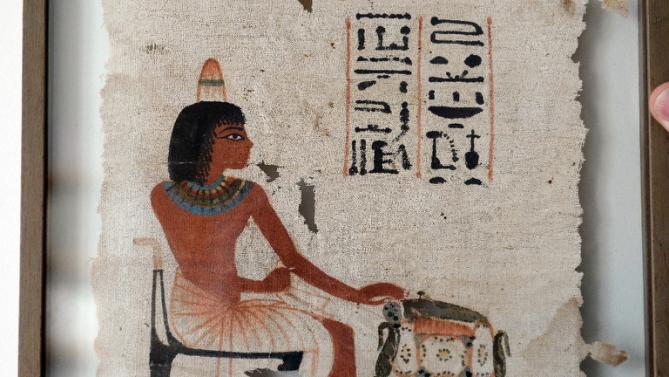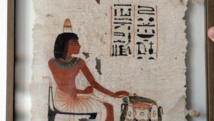The winning bid was made by telephone and the identity of the buyer was not disclosed.
The small vividly painted square of fabric belonged to a scion of the Goldman Sachs banking dynasty and later his lover, French author and publisher Jeanne Loviton.
Organisers had said they were not sure how much the 29-by-21 centimetre (11-by-eight inch) shroud, which would have been placed on the deceased's sarcophagus, would fetch.
Bidding started at 50,000 euros and wrapped up in a matter of minutes, organisers said.
Piasa's director Henri-Pierre Teissedre stumbled across the shroud six months ago while doing an inventory of a home in Paris that belonged to Loviton, who died in 1996. Her daughter owned the cloth at the time of the sale.
"This was a real discovery," archaeological expert Christophe Kunicki told reporters. "No one knew it existed."
The cloth is stamped with the name of a man called "Ta-nedjem", who died about 3,400 years ago.
It is made from the same type of cloth used to produce the bandages that wrap mummies and shows "Ta-nedjem" sitting on a black chair with a curved back and animal legs.
Given the richness of his clothing, ornaments and furniture, experts believe the man -- who was previously unknown to researchers -- was a person of status.
- Significant discovery -
Loviton herself was a woman of status in France. She was a novelist, lawyer and publisher of the work of Louis-Ferdinand Celine, best known for his novel "Journey to the End of the Night" ("Voyage Au Bout De La Nuit").
She also was the mistress of billionaire banker Arthur Sachs of the Goldman Sachs family.
He initially bought the shroud in 1927 as a gift for his wife. She kept it in the bathroom of their Paris residence but eventually returned it to her husband, who in turn presented it to his mistress, Loviton.
Loviton kept it at her home for the rest of her days. When the auction house found it, the cloth was hanging on a wall.
The chain of ownership prior to Sachs includes an antique dealer named Lucien Lepine, who bought the cloth in Egypt and later sold it to a dealer in Paris.
But how the ancient work of art came to be on the market in the first place is a mystery lost to the passage of time.
Experts believe there is little doubt as to the shroud's authenticity.
"This would have to be the work of an extremely talented forger and great Egyptologist, who would have had to use special pigments. That seems impossible," Annie Gasse, an expert with France's National Centre for Scientific Research, said.
Gasse is working on a book about the shroud, which is considered a significant discovery because it challenges previous findings about how many of the burial cloths are thought to exist.
------------------------------------------------------------------------------------------------------------------------------------
The small vividly painted square of fabric belonged to a scion of the Goldman Sachs banking dynasty and later his lover, French author and publisher Jeanne Loviton.
Organisers had said they were not sure how much the 29-by-21 centimetre (11-by-eight inch) shroud, which would have been placed on the deceased's sarcophagus, would fetch.
Bidding started at 50,000 euros and wrapped up in a matter of minutes, organisers said.
Piasa's director Henri-Pierre Teissedre stumbled across the shroud six months ago while doing an inventory of a home in Paris that belonged to Loviton, who died in 1996. Her daughter owned the cloth at the time of the sale.
"This was a real discovery," archaeological expert Christophe Kunicki told reporters. "No one knew it existed."
The cloth is stamped with the name of a man called "Ta-nedjem", who died about 3,400 years ago.
It is made from the same type of cloth used to produce the bandages that wrap mummies and shows "Ta-nedjem" sitting on a black chair with a curved back and animal legs.
Given the richness of his clothing, ornaments and furniture, experts believe the man -- who was previously unknown to researchers -- was a person of status.
- Significant discovery -
Loviton herself was a woman of status in France. She was a novelist, lawyer and publisher of the work of Louis-Ferdinand Celine, best known for his novel "Journey to the End of the Night" ("Voyage Au Bout De La Nuit").
She also was the mistress of billionaire banker Arthur Sachs of the Goldman Sachs family.
He initially bought the shroud in 1927 as a gift for his wife. She kept it in the bathroom of their Paris residence but eventually returned it to her husband, who in turn presented it to his mistress, Loviton.
Loviton kept it at her home for the rest of her days. When the auction house found it, the cloth was hanging on a wall.
The chain of ownership prior to Sachs includes an antique dealer named Lucien Lepine, who bought the cloth in Egypt and later sold it to a dealer in Paris.
But how the ancient work of art came to be on the market in the first place is a mystery lost to the passage of time.
Experts believe there is little doubt as to the shroud's authenticity.
"This would have to be the work of an extremely talented forger and great Egyptologist, who would have had to use special pigments. That seems impossible," Annie Gasse, an expert with France's National Centre for Scientific Research, said.
Gasse is working on a book about the shroud, which is considered a significant discovery because it challenges previous findings about how many of the burial cloths are thought to exist.
------------------------------------------------------------------------------------------------------------------------------------









 Home
Home Politics
Politics











